We sped out of Managua and into the countryside with a local at the wheel. Our host, degenerate TJ, had arranged for a rented vehicle from a local. Police tend to target obvious rental cars for “on the spot tickets,” occasionally taking the driver’s license for further fines to be paid at HQ days later.
There are vast stretches of Nicaragua that look like they have yet to advance out of the 19th century, particularly when a herd of cows, guided by men and, often, very young boys on horseback, blocks the dusty dirt road through the jungle.
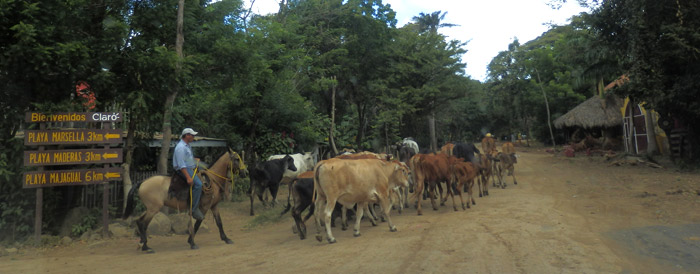
Less wealthy neighborhoods in the cities are crowded rows of cinder block, plywood, and corrugated metal. The countryside features lots of the same, but with far less density. You’ll see houses that the Big Bad Wolf could destroy with a sigh. I spotted a few farms where I couldn’t distinguish between the shack serving as a barn and the shack housing people – until I noticed the satellite dish atop one.
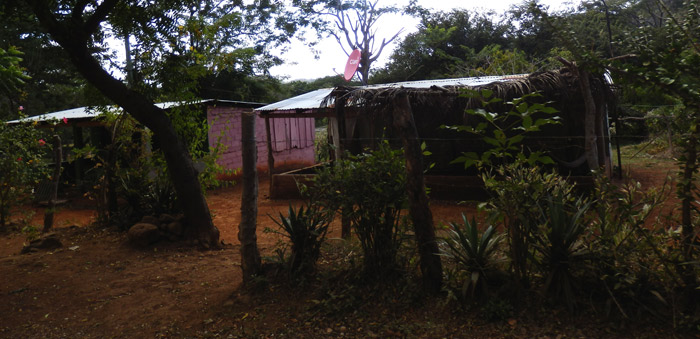
But look closely at the horse-drawn carts and you’ll see they have rubber tires. We passed fast food restaurants, new gas stations, roundabouts with impressive and surreal sculpture, absurdly decorated buses, and a long row of brand new power-generating wind turbines. Roadside fruit stands, handmade furniture shops, and boutiques selling amazing ceramics are also common.
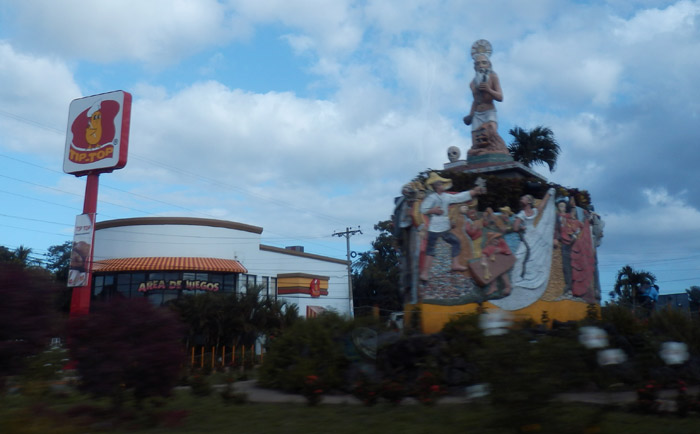
The southwest coast of Nicaragua is a long, wide string of volcanoes. The endless fields of sugarcane and plantains, as well as the coffee and cacao further north, are growing in rich, volcanic soil. Some of these volcanoes are currently active, at least one of which you can actually drive up (this is one of several things I regret not having time for during our trip, but there’s always next time, right?)
Arriving in late December, we saw Christmas decorations everywhere. La Semana Santa is a big deal in the almost-entirely Catholic nation. Rumor had it we shouldn’t try to visit San Juan del Sur during the holy week due to the craziness – drunken crowds, parades, fireworks, and stores bereft of goods. We wanted a little of the peril, so we arrived a few days after Christmas, a few days before New Years.
San Juan del Sur is nestled in a lovely, crescent-shaped port on the Pacific coast. The town is a major hub for surfers, so you’ll see tan, trim bodies everywhere. The bars and restaurants along the beachfront are exactly what Managua needs on the lake – clean, pretty, bustling, and serving up a wide variety of food and beverages (though at tourist prices.) A few hours in these bars and you’ll forget where you are. Occasionally, a cruise ship arrives and floods the place with day-trippers, making the place feel like any beachside town in Florida.
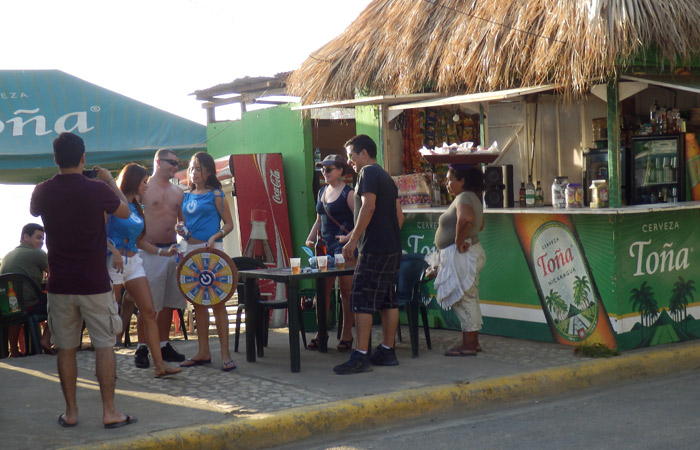
A few blocks off the beach you’ll find cheaper fare, including a few restaurants and markets that are targeted more at locals.
Speaking of the 19th century and boats, San Juan del Sur used to be on the trade and passenger route between the Atlantic and Pacific. Ships from the east would sail upriver to Lake Nicaragua unload at Rivas, then go 40 miles overland to San Juan del Sur to load onto ships there and continue on. San Juan was one of Mark Twain’s favorite haunts.
You may have to scroll to see the rest of the image below.

We settled in at TJ’s lovely house, admiring the new set of bars and screen over the courtyard that keep the howler monkeys and bats at bay.
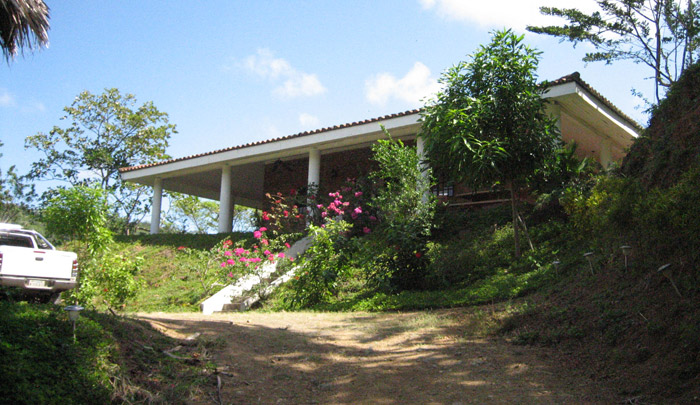
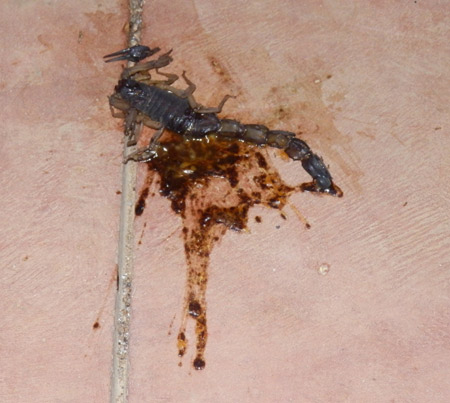 Over the course of the week, we’d get a glimpse of the howler monkeys, letting out their peculiar bark/grunts from the treetops. A swarm of termites attempted to invade a column on the porch, only to be repelled by the resident ants. Geckos appeared, too late to enjoy the feast.TJ played tag with a scorpion (though he won the war, it would be two days before he would regain feeling in his thumb.) A giant toad took up residence in the shower. Leave anything alone for a minute in the jungle and something is going to take it over!
Over the course of the week, we’d get a glimpse of the howler monkeys, letting out their peculiar bark/grunts from the treetops. A swarm of termites attempted to invade a column on the porch, only to be repelled by the resident ants. Geckos appeared, too late to enjoy the feast.TJ played tag with a scorpion (though he won the war, it would be two days before he would regain feeling in his thumb.) A giant toad took up residence in the shower. Leave anything alone for a minute in the jungle and something is going to take it over!
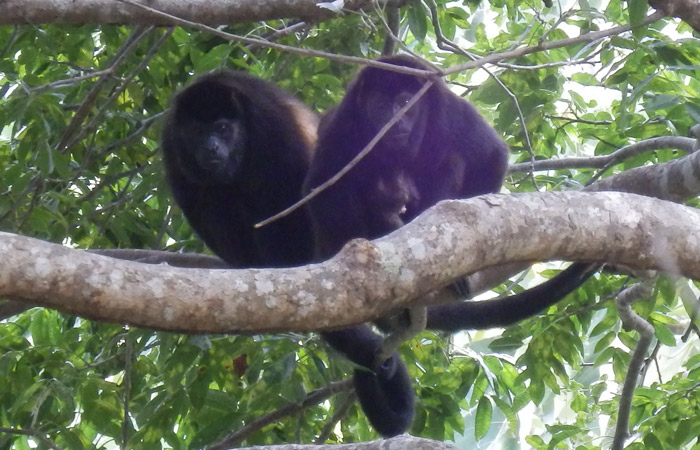
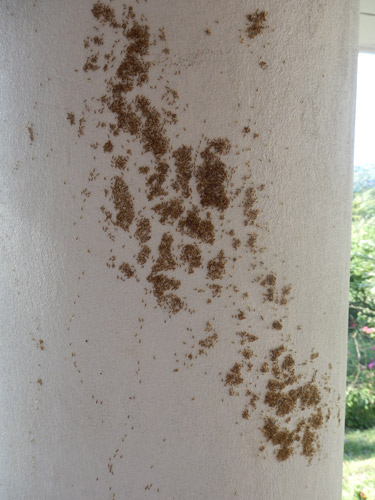
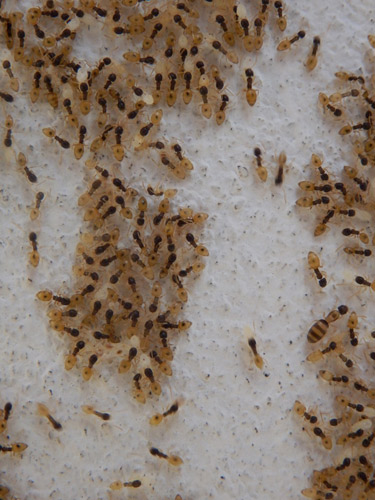
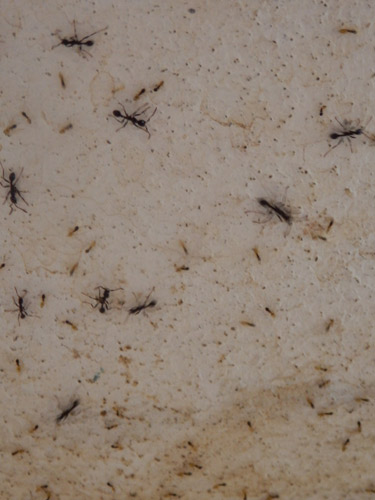
We took a short walk, admiring the view from the neighboring pastures of San Juan del Sur in the distance. The guy that owned the hills in the area had sold the low areas to the housing development, saving the best views for his cattle.
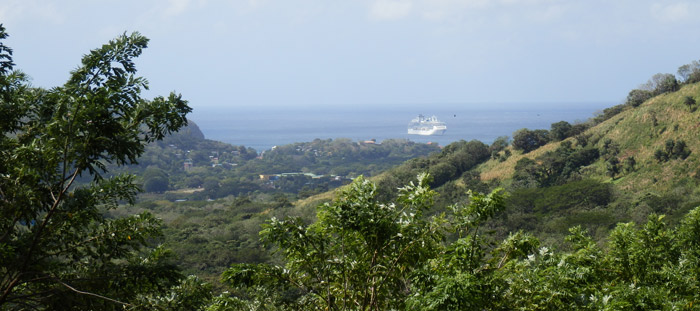
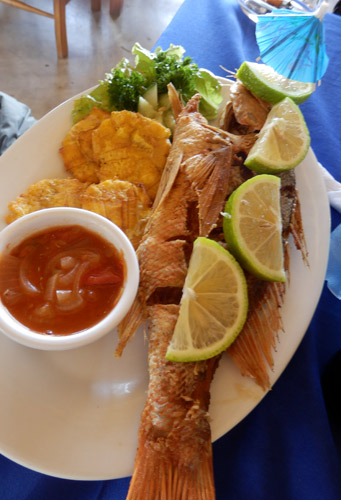 In town, we got seats on the rooftop deck of The Iguana overlooking the bay for a round of micheladas, a mix of hot sauce, lime, Worcestershire sauce, and beer. It’s sort of a Bloody Mary, sans tomato, and makes a great hangover helper or just everyday drink for hot climes. Down the block, we dined on ceviche and fish. Later, we’d return for dinner, eating at a restaurant specializing in steak cooked up by an Italian chef. We’d find that the tiny town hosted three pizza restaurants (one with another Italian chef), but it’s not just for tourists. Pizza is very popular across Nicaragua. We only sampled one of the pizza joints in San Juan and found it passable.
In town, we got seats on the rooftop deck of The Iguana overlooking the bay for a round of micheladas, a mix of hot sauce, lime, Worcestershire sauce, and beer. It’s sort of a Bloody Mary, sans tomato, and makes a great hangover helper or just everyday drink for hot climes. Down the block, we dined on ceviche and fish. Later, we’d return for dinner, eating at a restaurant specializing in steak cooked up by an Italian chef. We’d find that the tiny town hosted three pizza restaurants (one with another Italian chef), but it’s not just for tourists. Pizza is very popular across Nicaragua. We only sampled one of the pizza joints in San Juan and found it passable.
There are late night taco stands for the budget conscious, but probably the best meal for the cordobas was Juanita’s, a woman who grills up chicken, beef and pork on the street outside her tiny restaurant. You also get slaw, rice and beans, tortillas, plantain chips (or some kind of sweet), along with a beer for $5.
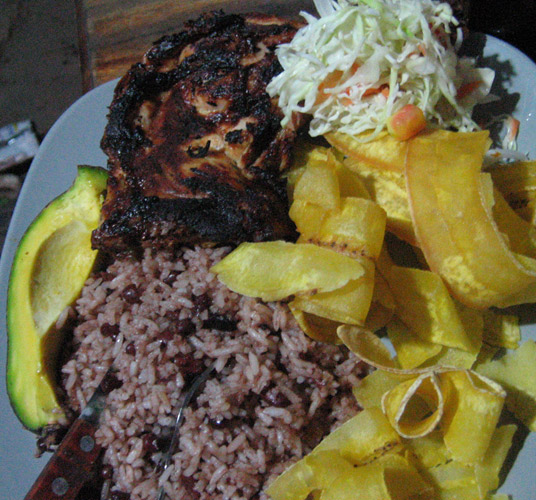
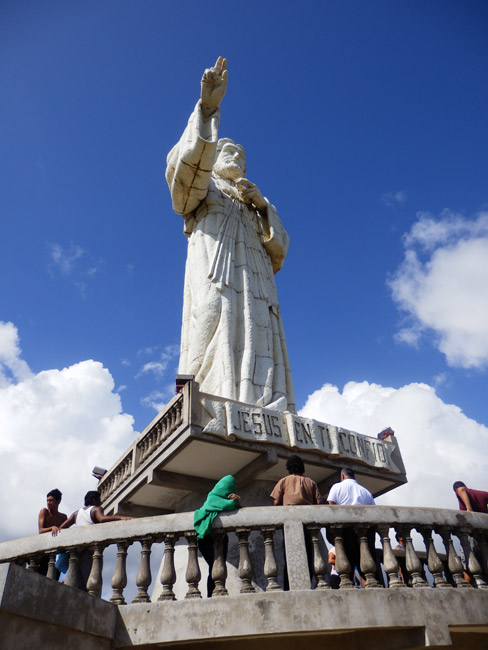 A cliff overlooking the northwest side of San Juan del Sur features a massive statue of Jesus, looking a bit like the Buddy Christ, watching over the bay. The road up to the site may be the steepest I have ever seen, but the sweeping views of San Juan del Sur, the surrounding bays, and the wealthy neighborhood on the hill are well worth the drive and small admission fee.
A cliff overlooking the northwest side of San Juan del Sur features a massive statue of Jesus, looking a bit like the Buddy Christ, watching over the bay. The road up to the site may be the steepest I have ever seen, but the sweeping views of San Juan del Sur, the surrounding bays, and the wealthy neighborhood on the hill are well worth the drive and small admission fee.
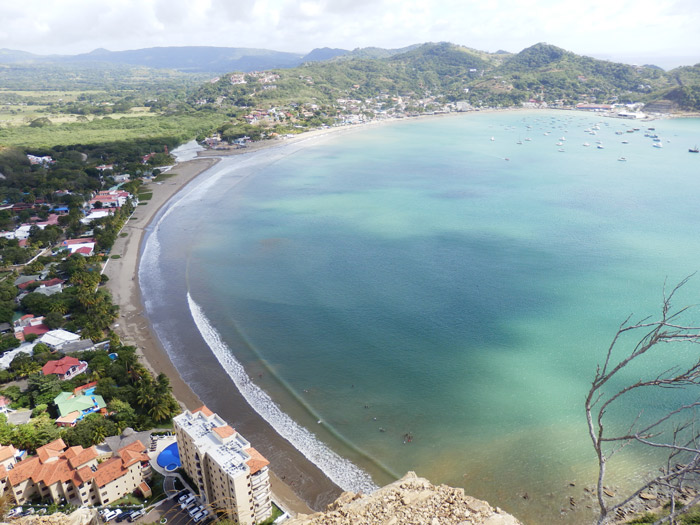

Just northwest of Jesus is a row of coves popular with surfers. Getting there can be a bit of a trek. The pavement ends just outside of San Juan, leaving travelers on a dirt road of varying quality. The truck we’d rented had four wheel drive, a necessity on the journey due to the steep hills covered in shifting soil just before you reach the beach. Though it is only a few kilometers, the drive took us 45 minutes.
We’d arrived before the surf was up, so we had a quiet walk around and enjoyed delicious fish tacos and piña coladas from the beachfront bar. Eventually, the place grew crowded with surfers from all over the world, from experts to novices. Some stay in the hostel on the beach, others at small hotels scattered all the way back to San Juan del Sur. You can recognize them vs. the non-surfing tourists by their tanned, battered bodies. Bruises and gashes abound. Between the rocks, the other surfers, and your own board, the large waves of Playa Maderas aren’t the best training ground for beginners. The photo below is just the start of the waves building.
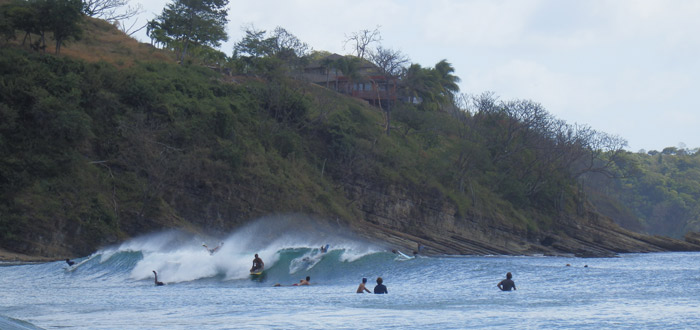
We walked to the next cove and found another beachfront restaurant and small hotel. The beach there was less about surfing than relaxing. We returned to this beach a few days later and had a fantastic time body surfing, pestering hermit crabs, eating tacos, and drinking beer.
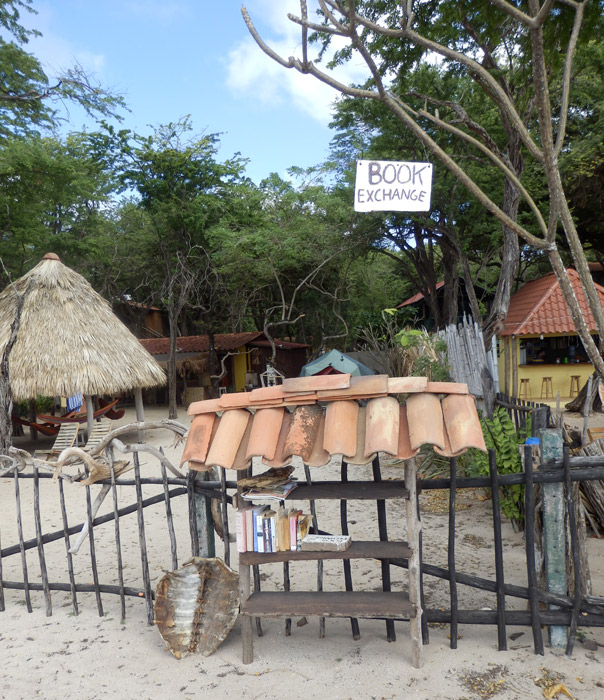
Watching a local guy teaching a young woman to surf, I had to wonder how often many nights the man sleeps alone. Handsome, perfectly toned, confidently showing an uncertain novice how to get up the board and catching her as she fell – I suspect the guy has no shortage of attention from his students. A life of surfing, fish tacos, rum and pussy. Why was I raised inland? He may not have a 401k, but when he gets tired of life he can always wade out into the sea and not come back. Or move to town and get a real job.
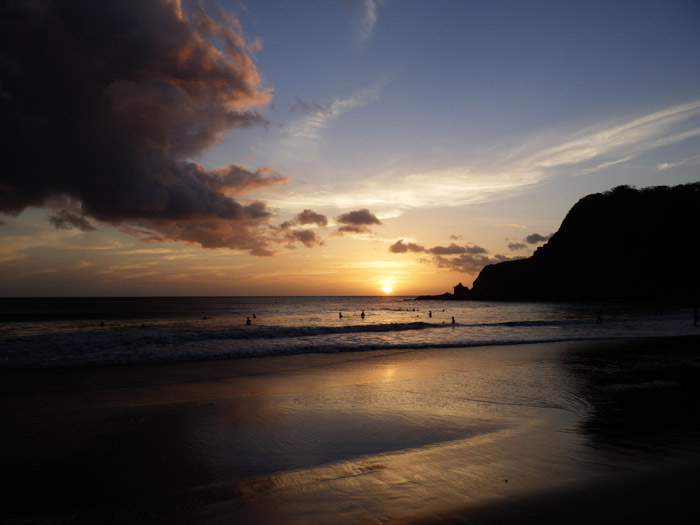
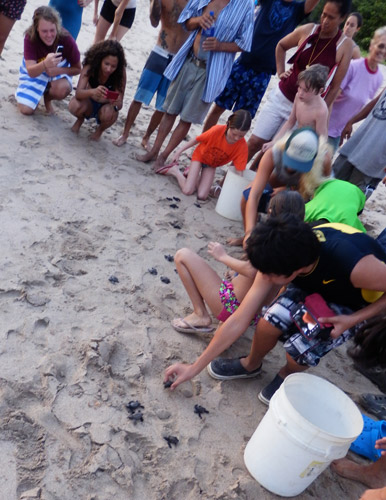 A group of people assembled on the beach. Out of curiosity, we wandered over to find a conservation group releasing baby turtles. We took bets as to which of the little creatures could crawl and flop into the sea first as the sun set over the water in purple and gold. A day like that can make one understand why there are more than a few people who have taken up full time life on the beach.
A group of people assembled on the beach. Out of curiosity, we wandered over to find a conservation group releasing baby turtles. We took bets as to which of the little creatures could crawl and flop into the sea first as the sun set over the water in purple and gold. A day like that can make one understand why there are more than a few people who have taken up full time life on the beach.
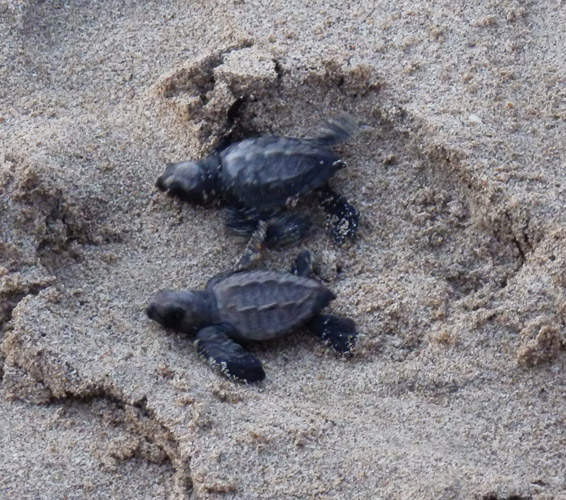
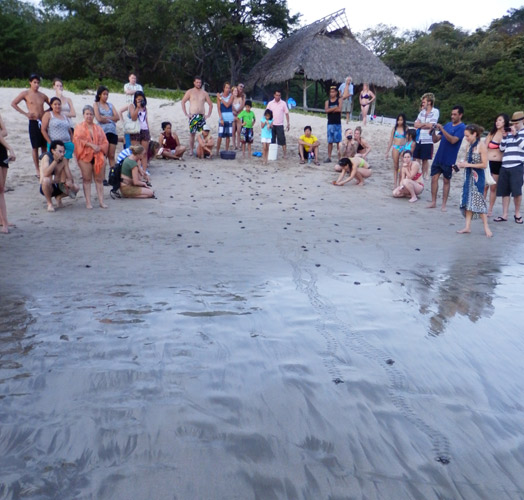
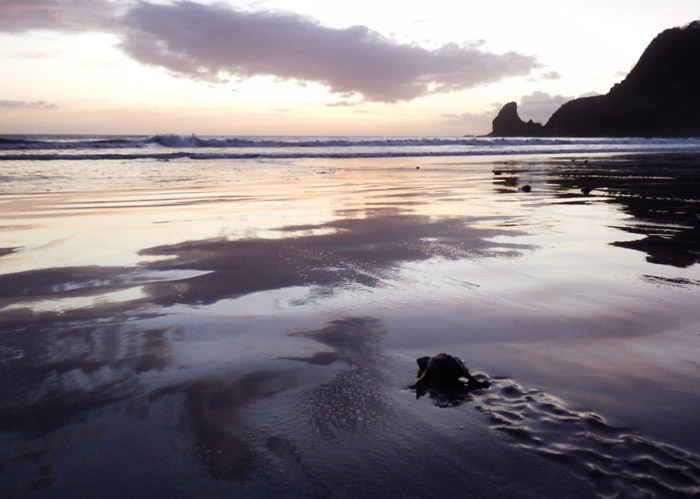
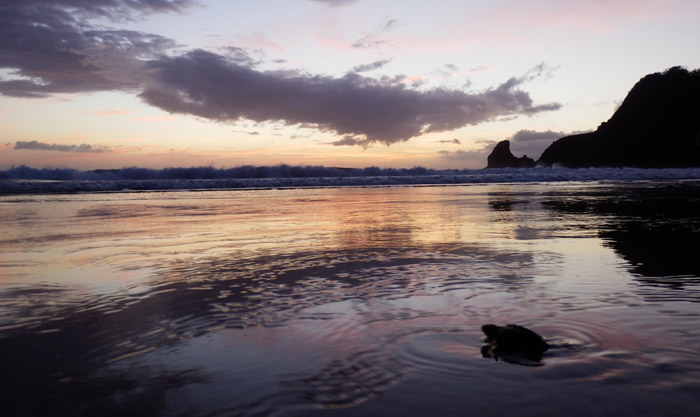
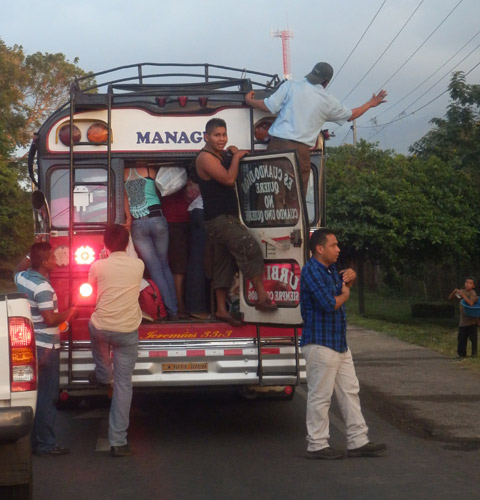 On one of our drives back to town, we stopped to pick up a hitchhiker. Locals will wave down any passing pickup and hop in back, usually riding standing up no matter how bouncy the road. The kid, maybe 12 years old, rode along for half an hour before tapping on the roof to let us know we’d reached his destination, or at least a fork we weren’t taking. We did this several times over the course of our trip. One cowboy, perhaps 16 years old, rode for 45 minutes before we picked up two backpackers. The three of them rode on to the next down, chatting away in the back of the truck. It seemed a better way to get around than the local buses. Nicaraguans pick up old school buses from the U.S., decorate them and put them into use. We saw some as crowded as a Tokyo subway.
On one of our drives back to town, we stopped to pick up a hitchhiker. Locals will wave down any passing pickup and hop in back, usually riding standing up no matter how bouncy the road. The kid, maybe 12 years old, rode along for half an hour before tapping on the roof to let us know we’d reached his destination, or at least a fork we weren’t taking. We did this several times over the course of our trip. One cowboy, perhaps 16 years old, rode for 45 minutes before we picked up two backpackers. The three of them rode on to the next down, chatting away in the back of the truck. It seemed a better way to get around than the local buses. Nicaraguans pick up old school buses from the U.S., decorate them and put them into use. We saw some as crowded as a Tokyo subway.
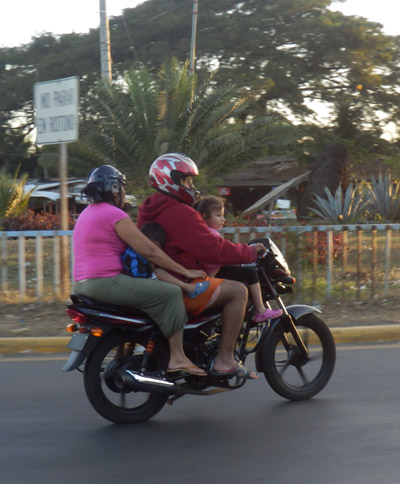 Also crowded – motorcycles. A common site is a toddler straddling the gas tank, dad at the handlebars, mom behind him with a baby sandwiched between them. Throw in a 50 pound sack of plantains balanced on the woman’s head and you’ve got a Nicaraguan full house.
Also crowded – motorcycles. A common site is a toddler straddling the gas tank, dad at the handlebars, mom behind him with a baby sandwiched between them. Throw in a 50 pound sack of plantains balanced on the woman’s head and you’ve got a Nicaraguan full house.
New Year’s Eve in San Juan del Sur is exciting. A bar set up temporary extra space out on the beach, complete with DJ booths and dance floors. The locals love their fireworks, which can be heard just about any day of the year. A small parade marched past. Fire dancers took up residence afterward, performing in the middle of the street. The bars were packed, some booming with disco, others with live bands, but we had a nice family dinner on a sidewalk table with some friends of degenerate TJ, and watched the chaos pass by.
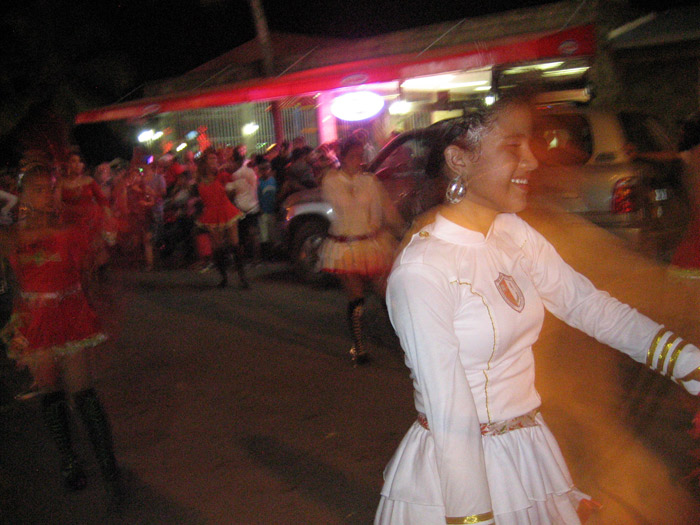
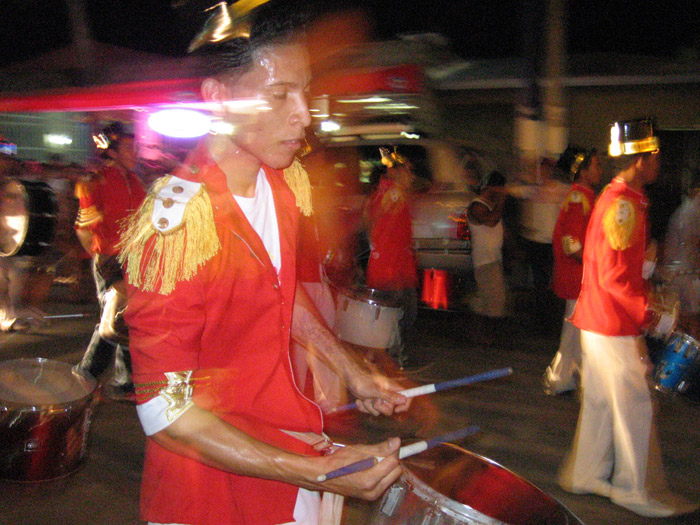
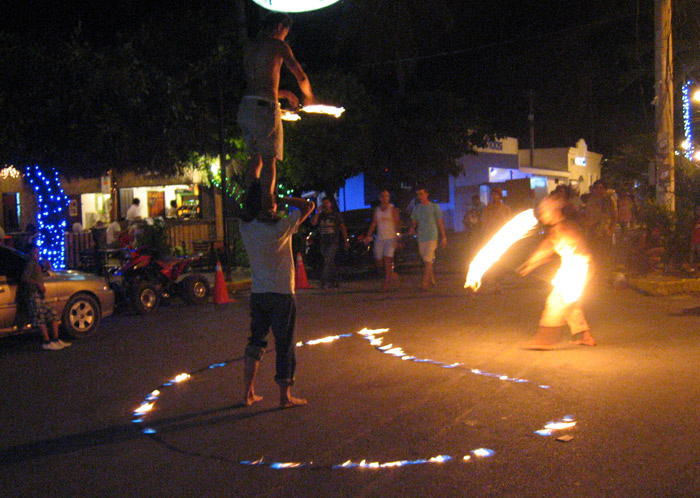
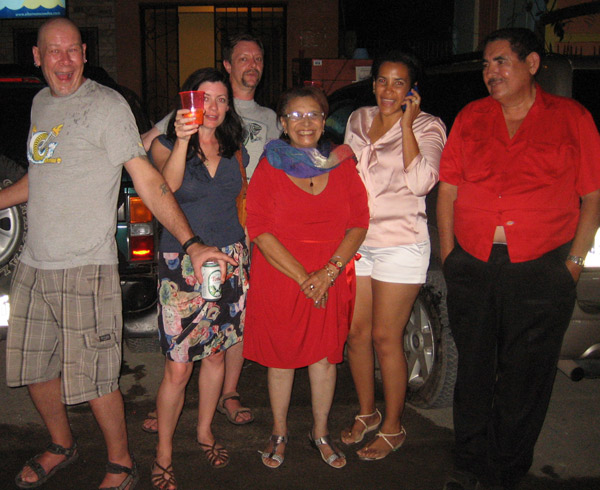
The family had a dummy, essentially an effigy of 2013, ready to burn but about 20 minutes before midnight an unseasonable rainstorm opened up and put a literal damper on the festivities. This may have been fortunate, as there were massive fireworks exploding just above the many grass-roofed buildings on the beach.
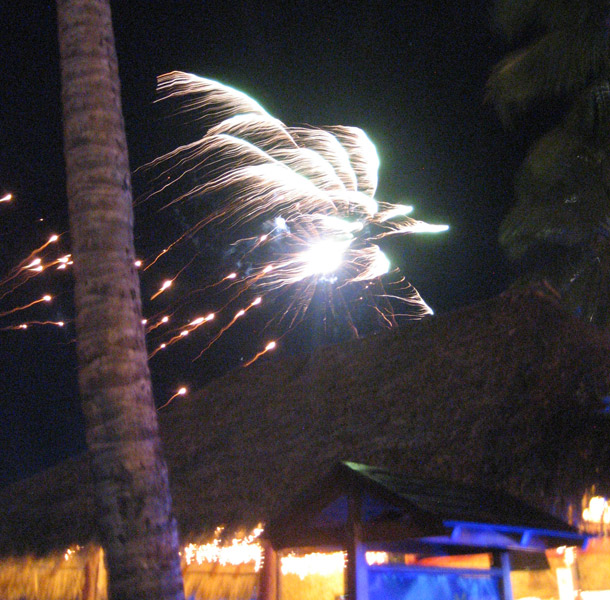
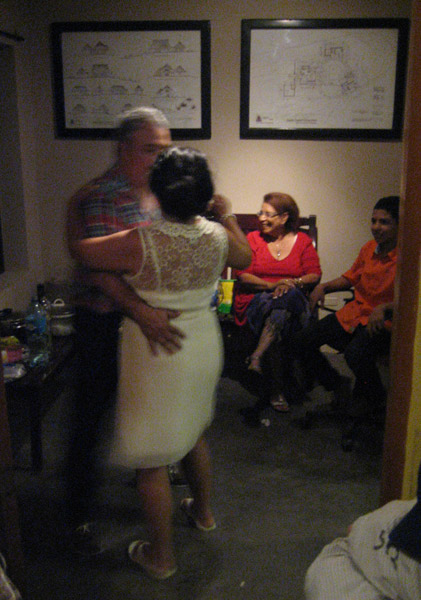 Most people were content to take shelter indoors or under the eaves. We watched our new friends dance in the office where we’d taken shelter. Degenerate CD took up the effigy and did a dance of his own.
Most people were content to take shelter indoors or under the eaves. We watched our new friends dance in the office where we’d taken shelter. Degenerate CD took up the effigy and did a dance of his own.
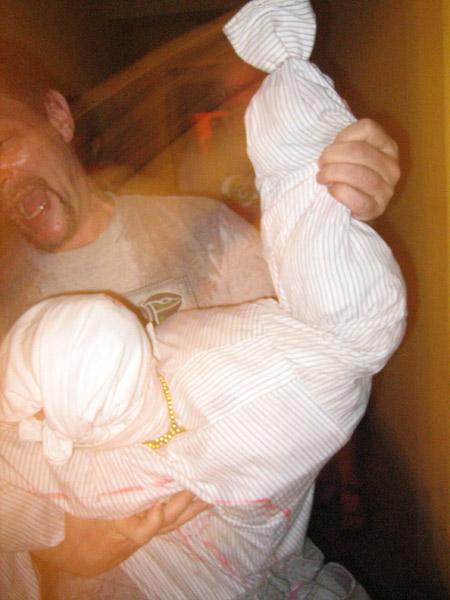
We trekked down the street during a rare break in the storm. On the ride home, we’d pass a dozen or more half-burned effigies in the streets, reminding us of passages from Blood of Brothers, a (highly recommended) book She Who Shall Not Be Named had been reading. It tells the tale of Nicaragua in the 1970s when there were actual bodies burning in the streets.
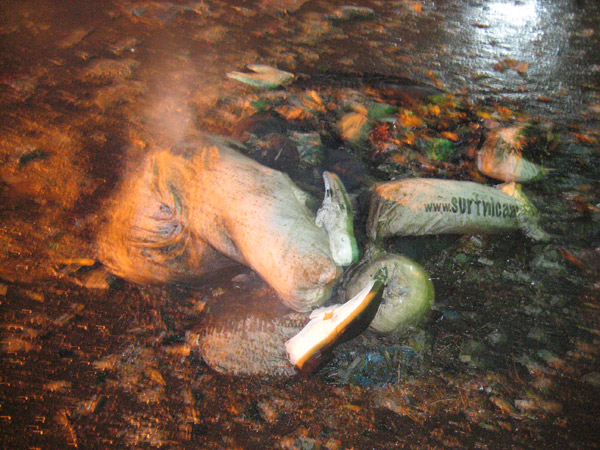
We celebrated our last night in San Juan del Sur with a ride into town Nicaraguan style, in the back of the truck, for drinks at Pelican Eyes, a spendy resort on the hill above town.
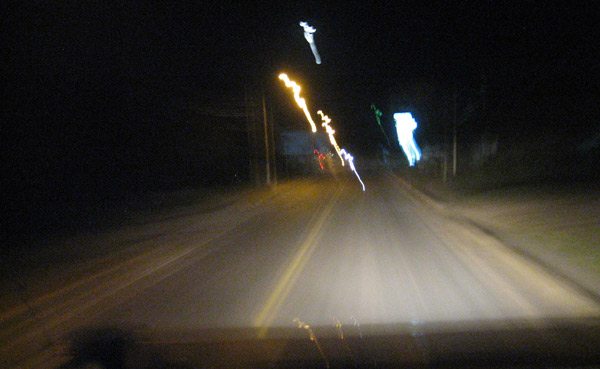
It’s worth a visit for their impressive patio bar. We had a few drinks looking over the pool to the view of the town and bay. A live band pumped out some Latin grooves (I’m on a strict no-more-cowbell diet for at least 60 days) as we headed off to dinner.
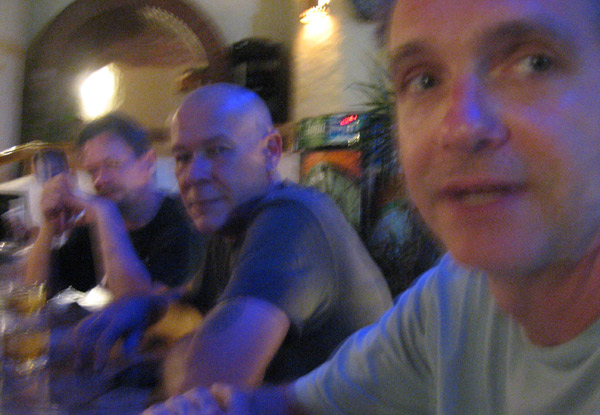
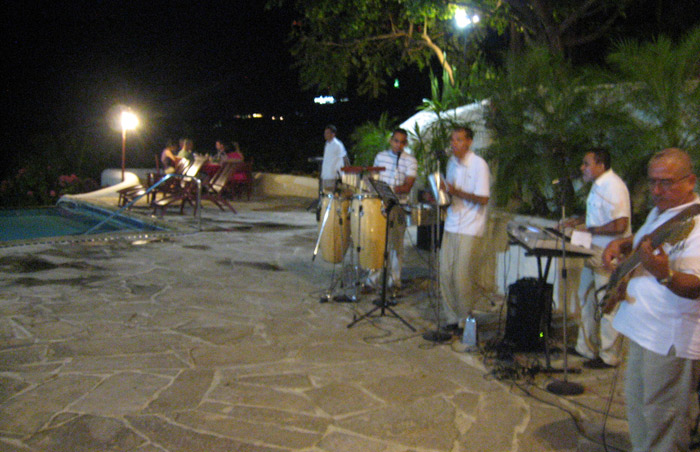
Just down the hill is El Calibri, a somewhat upscale establishment featuring cuisine from all over the world. For the money, I was almost wishing we’d dined at Juanita’s again, but it was nice to have a more relaxed atmosphere. The neighboring table raved about the sangrias, but we knew we’d be drinking more Flor de Caña later and the two probably wouldn’t play well together.
We made one last visit to The Iguana and found the place packed. A DJ was spinning up top 40 dance tunes, getting a few of the tourists moving, but it wasn’t until he switched over to Latin music that the joint really began to swing. After a week of too much rum, too much sun, and too much fun, we were too pooped to party hardy. We shuffled back toward the truck, passing another bar with Latin music that seemed to cater more to locals. Their feet were a blur on the dance floor. A couple of prostitutes propositioned TJ on the street, but rather than get rolled on the beach we let TJ surf the roads in the bed of the truck en route back to his place.
Nicaragua:
Managua
San Juan del Sur
Ometepe, Rivas, Masaya
Granada